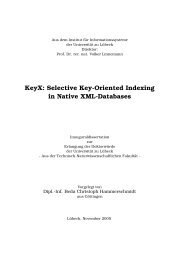Gesture-Based Interaction with Time-of-Flight Cameras
Gesture-Based Interaction with Time-of-Flight Cameras
Gesture-Based Interaction with Time-of-Flight Cameras
You also want an ePaper? Increase the reach of your titles
YUMPU automatically turns print PDFs into web optimized ePapers that Google loves.
CHAPTER 2. TIME-OF-FLIGHT CAMERAS<br />
camera.<br />
There exists, however, a simple approach to increase the non-ambiguity range.<br />
If two images are taken <strong>of</strong> the same scene <strong>with</strong> different modulation frequencies,<br />
one can reconstruct the distance unambiguously up to a range that corresponds to<br />
the least common multiple <strong>of</strong> the two corresponding non-ambiguity ranges. This<br />
procedure is limited to cases, where the objects undergo no or only limited motion<br />
in front <strong>of</strong> the camera. Otherwise, wrong distances will be estimated for pixels that<br />
move across object borders from one frame to the other and thus depict different<br />
objects at different distances in the two images.<br />
2.7.2 Systematic Errors<br />
As already mentioned in Section 2.6, TOF cameras can produce systematic errors, i.e.<br />
range measurement errors that are induced by deviations from an ideal sinusoidal<br />
signal e(t) <strong>of</strong> the illumination unit. Theoretically, these errors can be compensated<br />
by using a higher number <strong>of</strong> samples Ak to estimate the phase shift φ (Lange, 2000;<br />
Rapp, 2007). On the contrary, this is impractical as it would introduce higher com-<br />
putational cost and abet motion artefacts (Kolb et al., 2009).<br />
An alternative is to correct systematic errors in a post-processing step. This can,<br />
for example, be done using look-up tables (Kahlmann et al., 2007) or correction func-<br />
tions such as b-splines (Lindner and Kolb, 2006).<br />
2.7.3 Multiple Reflections<br />
The working principle <strong>of</strong> TOF cameras is based on the assumption that the modu-<br />
lated light that reaches a pixel is reflected from a single object at a well defined dis-<br />
tance and that the light travels directly back into the camera. In this case, the camera<br />
receives a single signal s(t) that has a phase shift φ <strong>with</strong> respect to the emitted signal<br />
e(t) that corresponds to the distance <strong>of</strong> the object. This assumption may be violated<br />
due to multiple reflections that can occur both in the scene and inside the camera.<br />
Multiple reflections in the scene refer to the situation when light <strong>of</strong> the active<br />
illumination travels not solely between the camera and the imaged object, but when<br />
it is reflected at additional objects in the scene along its path from the camera to the<br />
object and back to the sensor. In such a case, the distance travelled by the light is<br />
longer, which results in an increased time <strong>of</strong> flight and, thus, a false range estimate<br />
(Gudmundsson et al., 2007b).<br />
24<br />
Multiple reflections inside the camera have the effect that stray light from other

















